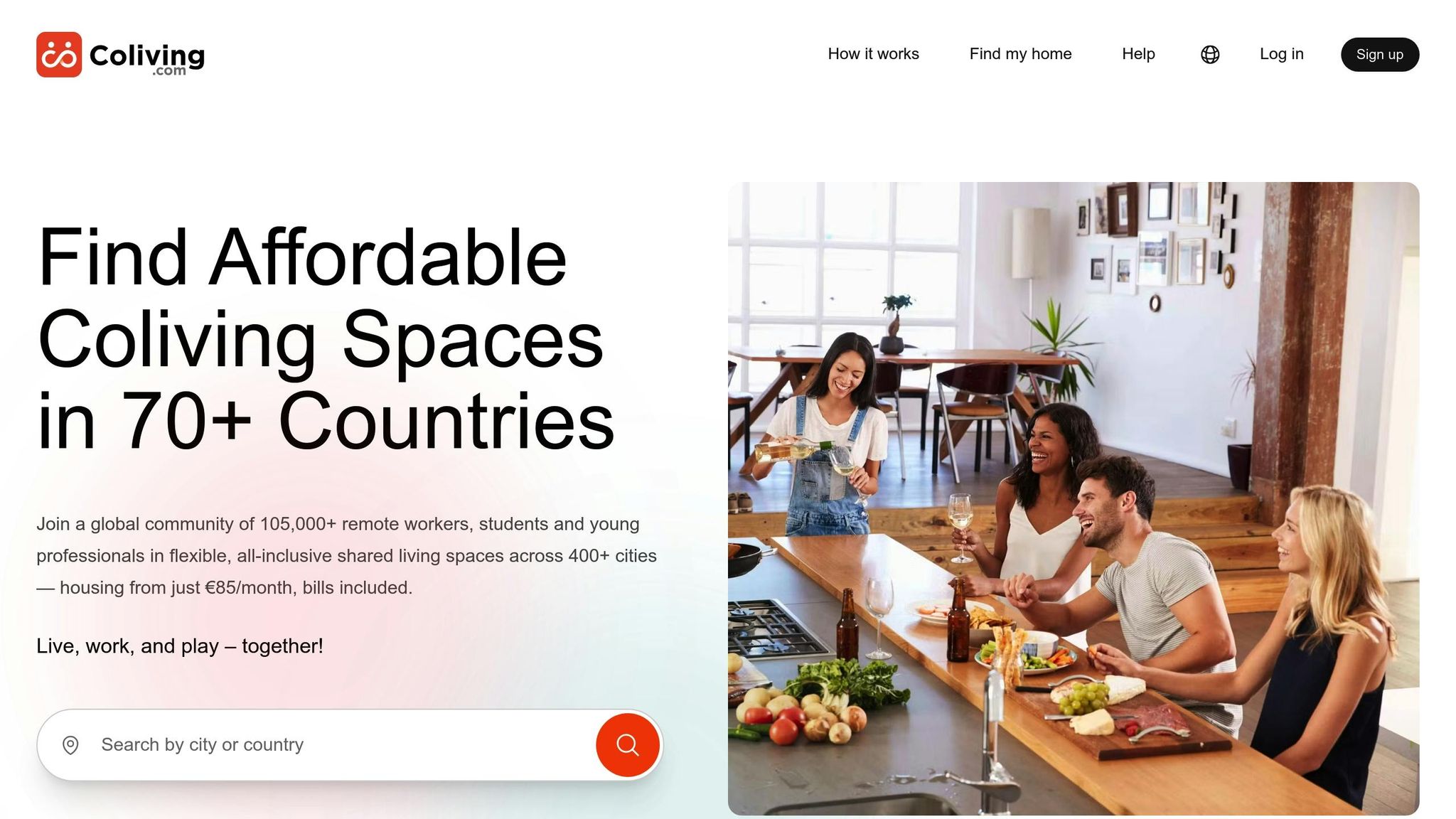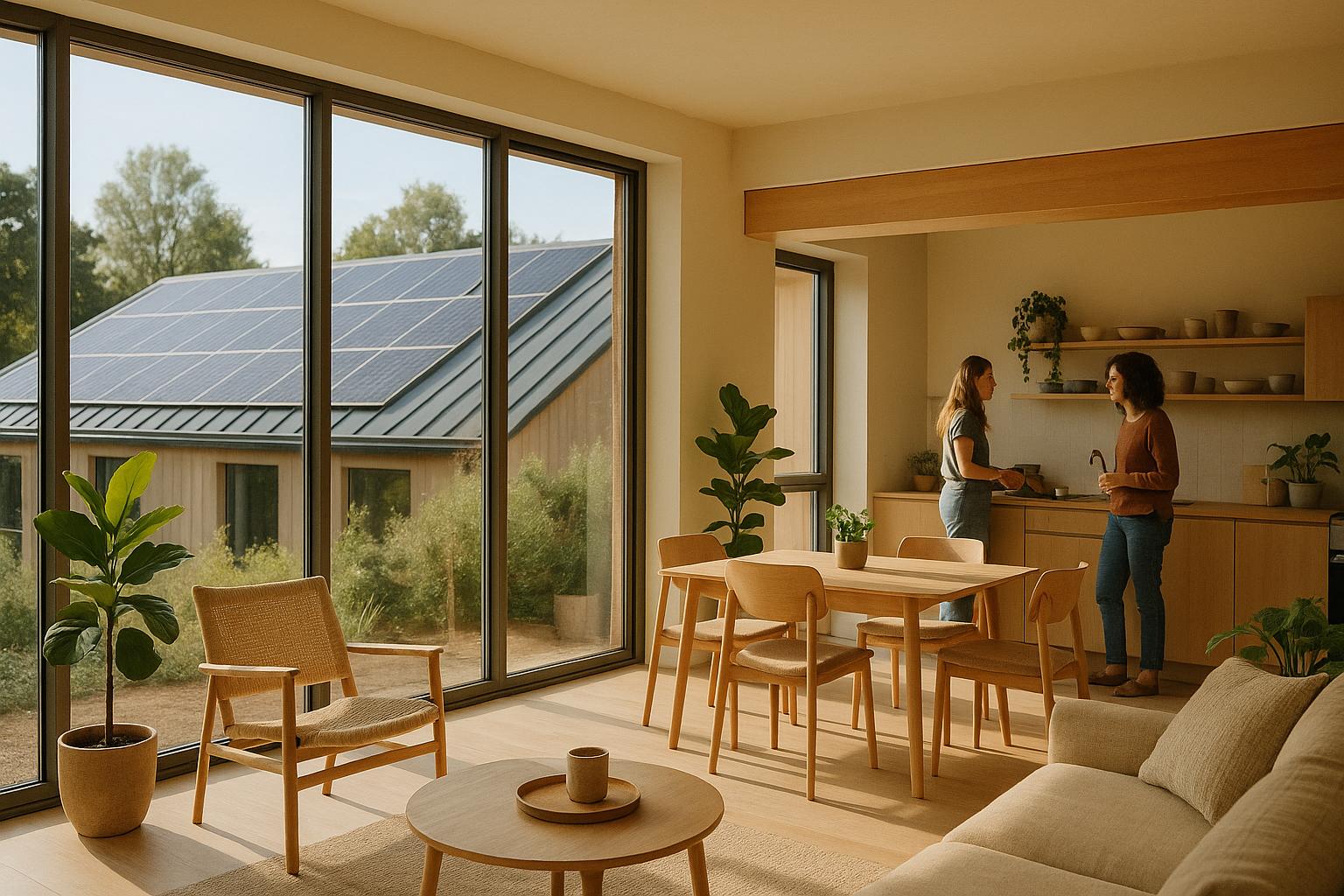Coliving is gaining traction as a practical solution to urban housing challenges in the U.S. It addresses three key issues: affordability, resource usage, and social isolation. By offering private bedrooms with shared communal spaces, coliving reduces costs, minimizes waste, and promotes social connections. Residents benefit from shared utilities, eco-friendly designs, and built-in communities, making it an efficient and community-focused alternative to traditional housing.
Key Points:
- Affordability: Shared spaces mean lower costs.
- Resource Efficiency: Shared utilities, appliances, and eco-friendly features reduce waste and energy use.
- Social Connection: Communal areas and events create opportunities for interaction.
Coliving platforms, like Coliving.com, simplify the process with all-inclusive pricing, flexible leasing, and online management. With over 1,900 spaces in 380 cities, coliving is reshaping urban living by combining cost savings, resource sharing, and community building.
How Coliving Supports Resource Efficiency
Shared Resource Usage
Coliving spaces are designed to make the most of shared resources by bundling essentials like electricity, water, gas, and Wi-Fi into a single, inclusive price. This setup encourages residents to be mindful of their consumption since everyone benefits from conserving resources. For instance, shared kitchen appliances serve multiple people, cutting down on the need for duplicate items and reducing overall energy usage. Plus, fully furnished spaces eliminate the hassle of buying and transporting furniture, significantly lowering material consumption and the environmental impact of manufacturing.
"The kitchen and living space had everything you need, plus the gym was a great amenity." - Kiev B.
Coliving also extends this efficiency to communal amenities like workspaces, laundry rooms, pools, and gyms. By sharing these facilities, residents avoid the waste associated with individual setups and can save up to 40% compared to living in a traditional studio apartment.
Waste Reduction Practices
Coliving communities take resource-sharing a step further by adopting thoughtful waste reduction practices. Many have robust recycling programs with clearly labeled bins for paper, plastic, glass, and organic waste. Some even partner with local facilities to ensure proper handling and processing. On-site composting systems are another common feature, turning food scraps into nutrient-rich soil for community gardens.
Shared living also reduces the need for duplicate household items like cleaning supplies, and many spaces embrace a circular economy by using second-hand furniture and encouraging the reuse or repurposing of items. Some communities even host workshops led by residents on topics like zero-waste living and sustainable food habits.
Another growing trend is the use of greywater recycling systems, which repurpose water from sinks and showers for landscaping, helping to significantly cut water usage.
Energy-Efficient Design Features
Coliving spaces go beyond shared resources and waste reduction by incorporating energy-efficient design. Smart technologies, such as programmable thermostats, LED lighting, and energy-efficient appliances, are commonly used to optimize energy consumption. Solar panels are often installed to provide renewable energy, offsetting a significant portion of electricity needs.
Many coliving spaces are also designed with natural lighting and ventilation in mind, reducing the need for artificial systems. Features like high-efficiency insulation, energy-saving windows, and water-efficient fixtures ensure a comfortable living environment while keeping energy and water usage to a minimum.
"The workspace and shared spaces were fantastic, including the rooftop, and my private area was just as impressive." - Tonette J.
Coliving.com: Modern Urban Housing Options

Coliving.com is a major platform that connects city dwellers with flexible, all-inclusive housing options. With over 38,000 rooms available across 380 cities, it caters to the growing demand for affordable, community-oriented living spaces. By focusing on cost-effectiveness, social connection, and efficient resource use, Coliving.com is reshaping urban housing.
Affordable and Flexible Housing Options
Coliving.com offers a budget-friendly way to live in urban areas, with prices starting as low as $100 per month. This shared-resource model splits costs among residents, making it an appealing alternative to traditional apartment rentals in major U.S. cities - all without compromising on quality.
What makes Coliving.com stand out is its seamless process. Everything is handled online, from booking to cancellations, and it even includes a money-back guarantee. This hassle-free approach is ideal for remote workers and young professionals seeking adaptable living arrangements.
The platform also works with a network of 750 hosts to maintain consistent quality while adding a personal touch to each community.
Community-Focused Living
Affordability is just one part of the equation. Coliving.com prioritizes creating spaces where residents can connect and build meaningful relationships. Many of the properties are designed to encourage interaction, with shared spaces that make it easy to meet and engage with others.
To simplify life even further, all-inclusive pricing covers essentials like Wi-Fi, utilities, and cleaning services. This not only reduces daily stress but also fosters a sense of togetherness among residents.
Prioritizing Resource Efficiency
With a curated selection of 1,900 coliving spaces, Coliving.com emphasizes resource efficiency through shared amenities that have been carefully vetted. These communal facilities help reduce waste and cut costs, all while supporting sustainable living practices. By focusing on efficient use of resources, the platform strengthens both environmental responsibility and the community bonds that define modern urban living.
Coliving vs. Standard Housing: A Comparison
Coliving brings together resource efficiency and a sense of community, offering a distinct alternative to traditional housing. Let’s break down how these two housing models stack up.
In traditional housing, residents are responsible for managing nearly every aspect of their living space - setting up utilities, arranging internet, furnishing their homes, and handling maintenance. This approach often results in duplicated resources, like multiple appliances or amenities, many of which are underutilized.
Coliving, on the other hand, centralizes these essentials. Instead of each unit having its own rarely-used amenities, coliving spaces provide shared fitness centers, coworking areas, and fully equipped kitchens that everyone can use. This setup not only reduces waste but also creates opportunities for residents to connect with one another.
For those living in expensive urban areas, coliving can also be a cost-effective option. With all-inclusive pricing, residents get utilities, Wi‑Fi, cleaning services, and furnishings bundled into one payment, simplifying budgeting and reducing overall expenses.
Comparison Table: Key Features
| Feature | Coliving | Standard Housing |
|---|---|---|
| Monthly Cost | Starting at $100 (all-inclusive) | Higher, with separate bills for utilities and furnishings |
| Setup Process | Fully online booking | Multiple applications, credit checks, and utility setups required |
| Utilities Included | Yes (Wi‑Fi, electricity, water, cleaning) | Typically billed separately |
| Furnishing | Fully furnished | Often unfurnished or partially furnished |
| Community Spaces | Shared kitchens, lounges, coworking areas, and fitness rooms | Limited to individual units |
| Waste Management | Centralized systems to minimize waste | Managed individually by each resident |
| Energy Efficiency | Shared systems like heating, cooling, and smart lighting | Separate systems with varied efficiency |
| Flexibility | Short-term leasing and easy cancellation | Longer-term leases with stricter terms |
| Social Connection | Built-in events and shared spaces | Minimal interaction with neighbors |
| Environmental Impact | Lower per-person resource usage | Higher resource consumption per resident |
Coliving’s shared amenities are designed to reduce waste and maximize efficiency. For example, communal appliances and fixtures get more use over time, lowering the overall environmental impact.
What’s more, coliving spaces are intentionally designed to foster community. Shared meals, coworking sessions, and planned activities create natural opportunities for residents to connect. This setup is particularly appealing to remote workers and digital nomads, who gain not only a fully equipped living space but also a built-in social and professional network. These thoughtful design elements blend practical living with meaningful connections, making coliving a modern solution for today’s housing needs.
Conclusion: Coliving as the Future of Urban Housing
Coliving is shaping up to be a practical solution for America's housing challenges. By cutting down on waste and costs while fostering a sense of community, this model meets the needs of growing urban populations and rising housing expenses.
Key Takeaways
Coliving offers a win-win for both residents and cities. Shared resources help reduce individual consumption without sacrificing quality of life. The all-inclusive pricing structure makes city living more attainable, especially for remote workers and recent graduates navigating high-cost markets. Plus, shared appliances and communal spaces cut down on unnecessary duplication, making coliving an efficient alternative to traditional housing setups.
But it’s not just about practicality - coliving also addresses social needs. Shared meals, coworking spaces, and group activities create opportunities for genuine connections, helping combat the isolation often felt in urban settings. With over 1,900 coliving spaces spread across 380 cities in more than 70 countries, the model’s rapid growth shows its potential to redefine housing norms in the U.S.
This combination of economic and social benefits sets the stage for coliving to evolve even further.
Future Trends in Coliving
As urban challenges persist, coliving is well-positioned to keep adapting. Its focus on affordability, resource efficiency, and community-building will remain a key draw. Moving forward, we can expect coliving spaces to become even more flexible, catering to the changing needs of residents. For instance, as remote work continues to reshape housing preferences, coliving spaces may evolve to include features that better support this lifestyle. These ongoing innovations promise to keep coliving relevant and responsive to the demands of modern urban living.
FAQs
How does coliving contribute to a more sustainable lifestyle compared to traditional housing?
Coliving offers a smart way to lessen environmental impact by promoting the sharing of resources and utilities. This setup naturally leads to lower energy usage, reduced water consumption, and less waste. Many coliving spaces are designed with efficiency in mind, often including energy-saving appliances, shared facilities, and layouts that prioritize eco-friendly practices.
On top of that, plenty of coliving communities take extra steps toward sustainability. They might use renewable energy, create green spaces, or implement effective waste management systems. These initiatives not only help shrink the carbon footprint but also encourage a greener, more responsible lifestyle for people living in bustling urban areas.
What are the social benefits of coliving, and how does it help reduce urban isolation?
Coliving offers a strong sense of community, making it easier for residents to build meaningful connections. Shared spaces and group activities naturally bring people together, creating opportunities for interaction and friendships. This can help combat the loneliness that often comes with city living.
Living in a communal environment also supports mental health and overall well-being. Having companionship and a sense of belonging can make a big difference in reducing feelings of isolation. By addressing the challenges of urban solitude, coliving provides a more connected and supportive way of life for those navigating the fast-paced rhythm of modern cities.
How does the cost of coliving compare to renting traditional housing in major U.S. cities?
Coliving often presents a more budget-friendly alternative to traditional housing in many major U.S. cities. Take New York City, for example: coliving spaces generally cost about $1,800 per month, while renting a studio apartment averages around $3,500. In Atlanta, coliving rates can start as low as $720, compared to the $1,700 price tag for a one-bedroom apartment.
By sharing amenities and cutting down on individual costs, coliving offers an economical option for urban residents, particularly in areas with steep housing prices. Beyond affordability, it also promotes a sense of community and shared living, which can be especially appealing in bustling city environments.






